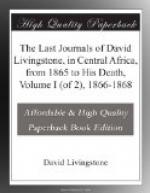We now crossed a brook, Chirongo, one yard wide and one deep; but our march was all through well-grown forest, chiefly gum-copal trees and bark-cloth trees. The gum-copal oozes out in abundance after or during the rains, from holes a quarter of an inch in diameter, made by an insect: it falls, and in time sinks into the soil, a supply for future generations. The small well-rounded features of the people of Nsama’s country are common here, as we observe in the salt-traders and villages; indeed, this is the home of the Negro, and the features such as we see in pictures of ancient Egyptians, as first pointed out by Mr. Winwood Reade. We sleep by the river Mandapala, 12 yards wide, and knee deep.
18th November, 1867.—We rest by the Kabusi, a sluggish narrow rivulet. It runs into the Chungu, a quarter of a mile off. The Chungu is broad, but choked with trees and aquatic plants: Sapotas, Eschinomenas, Papyrus, &c. The free stream is 18 yards wide, and waist deep. We had to wade about 100 yards, thigh and waist deep, to get to the free stream.
On this, the Chungu, Dr. Lacerda died; it is joined by the Mandapala, and flows a united stream into Moero. The statements of the people are confused, but the following is what I have gleaned from many. There were some Ujiji people with the Casembe of the time. The Portuguese and Ujijians began to fight, but Casembe said to them and the Portuguese, “You are all my guests, why should you fight and kill each other?” He then gave Lacerda ten slaves, and men to live with him and work at building huts, bringing firewood, water, &c. He made similar presents to the Ujijians, which quieted them. Lacerda was but ten days at Chungu when he died. The place of his death was about 9 deg. 32’, and not 8 deg. 43’ as in Mr. Arrowsmith’s map. The feud arose from one of Lacerda’s people killing an Ujijian at the water: this would certainly be a barrier to their movements.
Palm-oil trees are common west of the Chungu, but none appeared east of it. The oil is eaten by the people, and is very nice and sweet. This is remarkable, as the altitude above the sea is 3350 feet.
Allah is a very common exclamation among all the people west of Nsama. By advice of a guide whom we picked up at Kifurwa, we sent four fathoms of calico to apprise Casembe of our coming: the Arabs usually send ten fathoms; in our case it was a very superfluous notice, for Casembe is said to have been telegraphed to by runners at every stage of our progress after crossing the Kalongosi.
We remain by the Chungu till Casembe sends one of his counsellors to guide us to his town. It has been so perpetually clouded over that we have been unable to make out our progress, and the dense forest prevented us seeing Moero as we wished: rain and thunder perpetually, though the rain seldom fell where we were.
I saw pure white-headed swallows (Psalidoprocne albiceps) skimming the surface of the Chungu as we crossed it. The soil is very rich. Casembe’s ground-nuts are the largest I have seen, and so is the cassava. I got over a pint of palm oil for a cubit of calico.




